Diminution
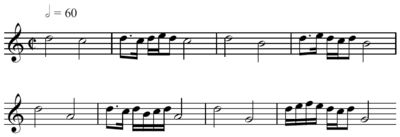

In Western music and music theory, diminution (from Medieval Latin diminutio, alteration of Latin deminutio, decrease) has four distinct meanings. Diminution may be a form of embellishment in which a long note is divided into a series of shorter, usually melodic, values (also called "coloration"). Diminution may also be the compositional device where a melody, theme or motif is presented in shorter note-values than were previously used. Diminution is also the term for the proportional shortening of the value of individual note-shapes in mensural notation, either by coloration or by a sign of proportion. A minor or perfect interval that is narrowed by a chromatic semitone is a diminished interval, and the process may be referred to as diminution (this, too, was sometimes referred to as "coloration").
Diminution as embellishment
Diminution is a form of embellishment or melodic variation in which a long note or a series of long notes is divided into shorter, usually melodic, values, as in the similar practices of breaking or division in England, passaggio in Italy, double in France and glosas or diferencias in Spain.[1] Thoroughly documented in written sources of the 16th, 17th and early 18th centuries, with a remarkable flowering in Venice from about 1580–1620, diminution is an integral aspect of modern performance practice. Donington describes the consequences of failing to add "necessary figuration" as "disastrous".[2]
Italian literature of the 16th and early 17th century
- Silvestro Ganassi Opera Intitulata Fontegara (Venice, 1535)
- Diego Ortiz, Nel qual si tratta delle Glose (1553)
- Giovanni Maffei, Delle lettere del Sr. Gio. Camillo Maffei da Solofra (1562)
- Girolamo Dalla Casa, Il vero modo di diminuir (1584)
- Giovanni Bassano, Ricercate, Passaggi et Cadentie (1585)
- Giovanni Luca Conforti, Breve et facile maniera d'essercitarsi a far passaggi (1593)
- Riccardo Rogniono, Passaggi per potersi essercitare nel diminuire terminatamente (1594)
- Giovanni Battista Bovicelli, Regole, passaggi di musica (1594)
- Aurelio Virgiliano, Il Dolcimelo (ms, c. 1600; first publication 1979)
- Francesco Rognoni Taeggio, Selve de varii passaggi (1620 )
- Giovanni Battista Spadi, Libro de passaggi ascendenti et descendenti (1624)
Spanish literature
English literature
- Christopher Simpson, The Division-Violist (1659)
- The Division-Violin (Playford, 1684)
- The Division Flute (Walsh, c. 1706)
German literature
- Adrianus Petit Coclico, Compendium Musices (Nuremberg, 1552)
- Michael Praetorius, Syntagma Musicum, book 3 (1618)
- Johann Andreas Herbst, Musica practica (1642)
Dutch literature
- Jacob van Eyck, Der Fluyten Lust-hof (Amsterdam, 1646) is a huge collection of diminutions.[3]
For Heinrich Schenker, "all foreground is diminution".[4] "All diminution must be secured firmly to the total work by means which are precisely demonstrable and organically verified by the inner necessities of the voice-leading".[5] This conception has been essential to Schenker's theory from some of his earliest writings.[6] In Schenkerian analysis a diminution is an elaboration by which an event formed of notes of longer value is expressed in notes of smaller value. See nonchord tone.
Diminution in composition

A melody or series of notes is diminished if the lengths of the notes are shortened; diminution is thus the opposite of augmentation, where the notes are lengthened. A melody originally consisting of four crotchets (quarter-notes) for example, is diminished if it later appears with four quavers (eighth-notes) instead. This technique is often used in contrapuntal music, as in the "canon by diminution" ("per diminutionem"), in which the notes in the following voice or voices are shorter than those in the leading voice, usually half the length.[7]
Diminution of note values
In mensural notation, diminution of the duration of note shapes is the most common function of coloration. Diminution is most often by one-third of the note-value, so that three colored notes fit into the time of two uncolored notes of the same shape; it is thus often found in notation of triplet or hemiola figures.[8][9]
Diminution may also be achieved by a sign of proportion. Thus a sign such as 3
2 is in proportional notation not a modern time signature, but a proportional signature indicating diminutio sesquialtera, that is, that after the sign each three notes of the basic note value integer valor occupy the time of two such notes elsewhere in the piece, either previously in the same voice, or simultaneously in another voice.[8]
Diminution of intervals
An interval is diminished if a minor or perfect interval is narrowed by a chromatic semitone; the process may occasionally be referred to as diminution. A diminished fifth interval is a chromatic semitone narrower than the perfect fifth, and a diminished seventh interval is a chromatic semitone narrower than the minor seventh. Diminished intervals are often used in jazz, art and Heavy Metal music, but not as often in pop music.
| Diminished second | Diminished third | Diminished fourth | Diminished fifth | Diminished sixth | Diminished seventh | Diminished octave |
|---|---|---|---|---|---|---|
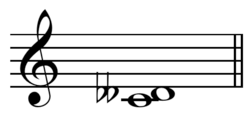 |
 |
 |
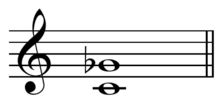 |
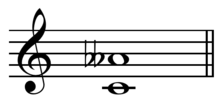 |
 |
 |
| | | | | | | |
a diminished unison is unthinkable, and the diminished 2d [sic] and 9th are of no practical use:...— Foote[10]
In the theory of harmony it is known that a diminished interval needs to be resolved inwards, and an augmented interval outwards.— Maria Renold (2004), p.15.[11]
Augmented intervals have a rather over-tense quality, while diminished intervals are experienced as rather cramped. Therefore, one may call the former luciferic in tendency and the latter ahrimanic.— Renold (2004), p.16
If a perfect or major interval is made one-half step larger (without changing its interval number) it becomes augmented. If a perfect or minor interval is made one-half step smaller (without changing its interval number) it becomes diminished.— Benward & Saker (2003), p.54.[12]
Most nonharmonic tones are dissonant and create intervals of a second, fourth, or seventh. Diminished or augmented intervals are also considered dissonant.— Benward & Saker (2003), p.92.[13]
The standard abbreviations for diminished intervals are dX, such that a diminished third = d3.[12]
Diminished chords

A diminished triad consists of two superposed minor thirds, and thus contains a diminished fifth. In classical repertoire the usual symbol is the degree, °, as in vii°. In lead sheets and popular music books it is usually written Cdim or C°.

A diminished seventh chord consists of three superposed minor thirds, and thus has all successive notes a minor third apart; it contains two diminished fifths. In jazz theory, a diminished seventh chord has four available tensions, each a major ninth above the chord tones, and thus forming a diminished seventh chord a whole tone (or major ninth) above the root chord. Because any chord tone of the diminished seventh can be heard as the root, the tensions are not numbered as ninth, eleventh and so on. The usual notation is Cdim7 or C°7, but some lead sheets or popular music books may omit the 7.

A diminished triad with a minor seventh is a half-diminished chord, usually notated either Cm7(♭5) or Cø7.
Diminished scales
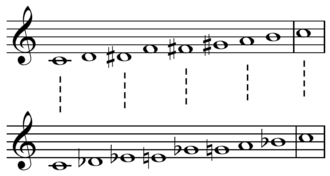
Several scales may be referred to as diminished. One of the more common is the Octatonic scale constructed from C°7 and its tensions (transposed into the same octave), which has alternating tone and semitone intervals.

See also
Sources
- ↑ Garden, Greer, and Robert Donington. "Diminution". Grove Music Online. Oxford Music Online. Retrieved August 2011. Check date values in:
|access-date=(help) (subscription needed) - ↑ Donington, Robert (1989). The Interpretation of Early Music (New revised ed.). London: Faber and Faber. pp. 152–188. ISBN 0-571-15040-3.
- ↑ Conforto, Giovanni Luca (1986). Giancarlo Rostirolla, ed. Breve et facile maniera d'essercitarsi a far passaggi, Roma 1593 (in Italian). Roma: Società Italiana dl Flauto Dolco. p. 3.
- ↑ Schenker, Heinrich (1979). Free Composition. Translated by Ernst Oster. New York, London: Longman. pp. 96, § 252.
- ↑ Schenker, Heinrich (1979). Free Composition. Translated by Ernst Oster. New York, London: Longman. pp. 98, § 253.
- ↑ Schenker, Heinrich (1908) [1904]. Ein Beitrag zur Ornamentik als Einführung zu Ph. Em. Bach's Klavierwerken. Wien, Leipzig: Universal Edition.
- ↑ Jeppesen, Knud. Counterpoint: The Polyphonic Vocal Style of the Sixteenth Century. trans. Glen Haydon. New York: Dover Publications. 1992. p. 235 . ISBN 978-0-486-27036-4. Missing or empty
|title=(help) - 1 2 Bowers, Roger. "Proportional notation". Grove Music Online. Oxford Music Online. Retrieved August 2011. Check date values in:
|access-date=(help) (subscription needed) - ↑ Donington, Robert, and Peter Wright. "Coloration". Grove Music Online. Oxford Music Online. Retrieved August 2011. Check date values in:
|access-date=(help) (subscription needed) - ↑ Arthur Foote, Walter Raymond Spalding (1905). Modern Harmony in its Theory and Practice, p.5. Arthur P. Schmidt.
- ↑ Renold, Maria (2004). Intervals, scales, tones and the concert pitch, p.15. ISBN 1-902636-46-5.
- 1 2 Benward & Saker (2003). Music: In Theory and Practice, Vol. I, p.54. ISBN 978-0-07-294262-0.
- ↑ Benward & Saker (2003), p.92. Benward & Saker (2009). Music: In Theory and Practice, Vol. II, p.36. ISBN 978-0-07-310188-0.